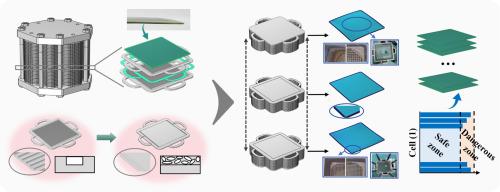Solid oxide cell stack operating parameter optimization considering various stresses
IF 9.4
1区 工程技术
Q1 ENGINEERING, MECHANICAL
International Journal of Mechanical Sciences
Pub Date : 2025-09-22
DOI:10.1016/j.ijmecsci.2025.110877
引用次数: 0
Abstract
In this study, the finite element method is applied to evaluate and optimize operating parameters for large-scale solid oxide cell stacks by involving detailed-structure stress model and homogenized-structure multi-physics computational fluid dynamics model. A proposed one- and two-step temperature gradient evaluation method (combining end-plate unilateral difference and internal-cell central difference) is employed to establish a quantitative relationship between inter-cell temperature gradients and maximum stress, and to define a “safe operating window” criterion. It is found that cell residual stress establishes a preloaded mechanical state and dominates multi-stress coupling affecting the stress distribution in the stack. When further coupled with bolt-preload-induced assembly stress, the compressive stress is amplified in critical regions from 62.92 MPa (the assembly stress alone) to 565.81 MPa, while the stress concentration is intensified on vulnerable areas such as the electrolyte layers. Subsequent coupling with the stack operation-induced thermal stress drives the tensile stress to 700–1000 MPa. This multi-stress coupling narrows the operating window, with critical temperature gradient thresholds identified as 36.4 K·cm⁻¹ and 40.2 K·cm⁻¹ under assembly-thermal coupling, and 21.5 K·cm⁻¹ and 29.1 K·cm⁻¹ when all stresses are included. Guided by the safe threshold of 21.5 K·cm⁻¹, the stack operating parameters are further optimized to balance the trade-off between electrochemical performance and mechanical constraints.

考虑各种应力的固体氧化物电池堆运行参数优化
本文采用有限元方法,结合细观结构应力模型和均质结构多物理场计算流体动力学模型,对大型固体氧化物电池堆的运行参数进行了评估和优化。提出了一阶和两阶温度梯度评价方法(结合端板单侧差和胞内中心差),建立胞间温度梯度与最大应力之间的定量关系,并定义了“安全操作窗”准则。研究发现,胞体残余应力形成了一种预加载的力学状态,并主导了多应力耦合,影响了堆内的应力分布。当再加上螺栓预紧力引起的装配应力时,临界区域的压应力从62.92 MPa(单独的装配应力)放大到565.81 MPa,而电解液层等脆弱区域的应力集中加剧。随后与叠垛作业引起的热应力耦合,将拉应力提高到700-1000 MPa。这种多重压力耦合缩小了操作窗口,装配-热耦合的临界温度梯度阈值确定为36.4 K·cm⁻¹和40.2 K·cm⁻¹,当所有压力都包括在内时,临界温度梯度阈值确定为21.5 K·cm⁻¹和29.1 K·cm⁻¹。在21.5 K·cm(⁻¹)的安全阈值指导下,进一步优化了堆叠操作参数,以平衡电化学性能和机械约束之间的权衡。
本文章由计算机程序翻译,如有差异,请以英文原文为准。
求助全文
约1分钟内获得全文
求助全文
来源期刊

International Journal of Mechanical Sciences
工程技术-工程:机械
CiteScore
12.80
自引率
17.80%
发文量
769
审稿时长
19 days
期刊介绍:
The International Journal of Mechanical Sciences (IJMS) serves as a global platform for the publication and dissemination of original research that contributes to a deeper scientific understanding of the fundamental disciplines within mechanical, civil, and material engineering.
The primary focus of IJMS is to showcase innovative and ground-breaking work that utilizes analytical and computational modeling techniques, such as Finite Element Method (FEM), Boundary Element Method (BEM), and mesh-free methods, among others. These modeling methods are applied to diverse fields including rigid-body mechanics (e.g., dynamics, vibration, stability), structural mechanics, metal forming, advanced materials (e.g., metals, composites, cellular, smart) behavior and applications, impact mechanics, strain localization, and other nonlinear effects (e.g., large deflections, plasticity, fracture).
Additionally, IJMS covers the realms of fluid mechanics (both external and internal flows), tribology, thermodynamics, and materials processing. These subjects collectively form the core of the journal's content.
In summary, IJMS provides a prestigious platform for researchers to present their original contributions, shedding light on analytical and computational modeling methods in various areas of mechanical engineering, as well as exploring the behavior and application of advanced materials, fluid mechanics, thermodynamics, and materials processing.
 求助内容:
求助内容: 应助结果提醒方式:
应助结果提醒方式:


